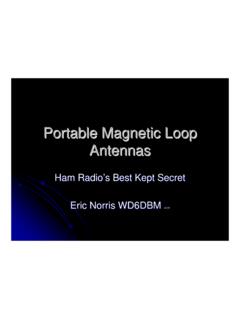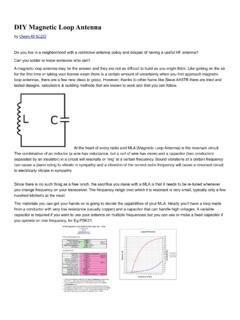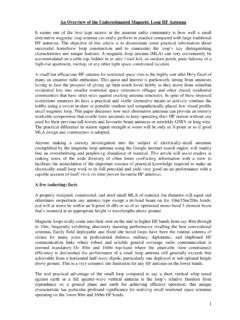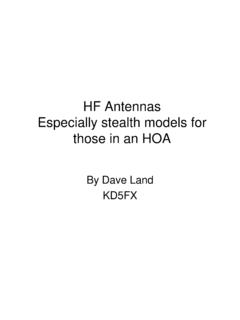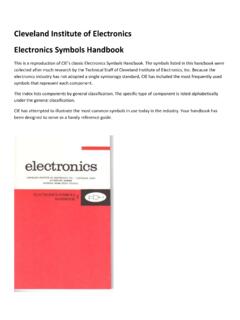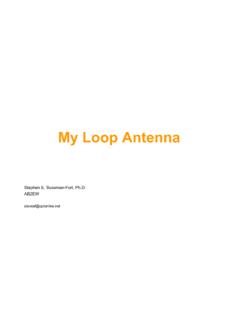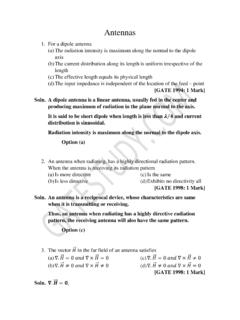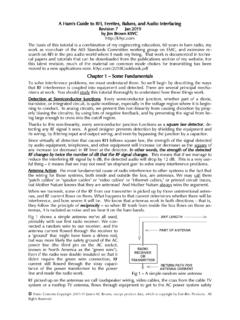Transcription of Easy to Build Low Band Receiving Antennas for Small and ...
1 Easy to Build Low Band Receiving Antennas for Small and Large Lots Small Antennas High performance Antennas Quantitative performance evaluation Frank Donovan W3 LPL Dayton 2016 Why Receiving Antennas ? Much better performance than most transmitting Antennas much lower cost greatly reduced footprint greatly reduced height (7 to 25 feet) good directivity on as little as 650 to 2500 square feet excellent directivity on less than an acre directivity equivalent to a 5 element Yagi on less than 3/4 acre greatly reduced mutual coupling between individual verticals greatly reduced need for efficient matching and extensive radial systems High performance arrays perform equivalent to a 5 element Yagi!
2 Combining two Antennas with a variable phase controller steerable nulls optimizes the front-to-back ratio of phased arrays of Beverages and verticals Diversity reception with dual phase locked receivers All Receiving Antennas dimensions are for 160 meters - simply scale them to 80 meters Receiving Directivity Factor (RDF) proven measure of Receiving antenna performance Compares forward gain at the desired azimuth and elevation angle to average gain over the entire hemisphere EZNEC computes antenna RDF Assumes noise is equally distributed over the entire hemisphere an invalid assumption for suburban and especially urban locations where noise is often concentrated on the horizon Assumes that RFI is more then 1000 feet away, in the far field of the antenna where the antenna pattern of large Antennas is fully formed.
3 And RFI sources look more like a point sources Re-radiation from Antennas , towers and power lines within about 1000 feet can degrade your actual RDF especially for high RDF arrays Small Receiving Antennas 4 to 9 dB RDF 4 dB: Bidirectional 8 foot diameter magnetic loop close to the ground 5 dB: Single vertical antenna (short vertical or wavelength vertical) 6 dB: 225 foot Beverage on Ground (BOG) 6 dB: 250 to 400 foot Beverage about 7 feet high 7 dB: Unidirectional terminated Small loop flag, pennant, EWE, VE3DO 8 dB: Close spaced arrays of two Small terminated loops K9AY Array Shared Apex Loop Array 8 dB: Pair of 250 to 400 foot staggered Beverages about 7 feet high 9 dB: Two phased short verticals with 60 to 80 foot spacing 9 dB: Triangle array of phased short verticals with 60 to 80 foot spacing Small Antennas are the best RFI reduction Antennas when your RFI sources are within about 1000 feet of your antenna High Performance Receiving Antennas 10 to 14 dB RDF 10 dB: 500 to 600 foot Beverage about 7 feet high 11 dB.
4 Two or three close spaced 500 to 600 foot Beverages, staggered 125 feet 12 dB: 4 square array of active or passive short verticals 80 x 80 ft 12 dB: 3 element YCCC tri-band array of short active verticals 120 ft long 12 dB: 5 element YCCC tri-band array of short active verticals 84 x 84 ft 12 dB: 9-circle YCCC tri-band array of short active verticals 120 ft diameter 12 dB: Horizontal Waller Flag: 2 phased horizontal loops well over 100 ft high 13 dB: BSEF array of 4 short verticals switchable in two directions 350 ft x 65 ft 13 dB: 8-circle array of short verticals with 106 phasing 200 ft diameter 13 dB: 8-circle BSEF array of short passive verticals 350 ft diameter + radials 14 dB.
5 Four broadside/end-fire 800 foot Beverages 800 ft x 330 ft Large Receiving Antennas are less effective at suppressing local RFI sources within a few thousand feet of the antenna Small Loop Antennas 4 to 7 dB RDF 120 to 150 Beamwidth 8 foot diameter magnetic loop 4 dB RDF bi-directional 150 degree beamwidth installed close to the ground to suppress horizontally polarized RFI a specialized antenna for steering a very deep null onto a single ground wave propagated RFI source poor sensitivity for DX compared to larger Antennas Unidirectional terminated Small loops 6 to 7 dB RDF flag pennant EWE K9AY VE3DO Mechanically rotatable unidirectional terminated Small loops rotatable flag Small Antennas are the best RFI reduction antenna when the RFI sources are within 1000 feet of your antenna Arrays of Small loops 8 to 11 dB RDF 80 to 120 Beamwidth Electrically steerable compact arrays of two Small loops Two switchable K9AY loops 8 to 9 dB RDF Shared Apex Loop Array
6 8 to 9 dB RDF 350 foot broadside spaced pair of Small loops 9 to 10 dB RDF pennant EWE K9AY VE3DO Mechanically steerable array of two Small loops 10 to 11 dB RDF Vertical Waller Flag Small Antennas are the best noise reduction antenna when your RFI sources are within 1000 feet of your antenna BOGs and BOG Arrays 6 to 8 dB RDF 60 to 90 Beamwidth BOG 6 dB RDF 90 beamwidth 225 foot wire laid just above the surface of the ground Switchable bi-directional BOG 6 dB RDF 90 beamwidth 225 foot coaxial cable laid just above the surface of the ground Close spaced staggered BOGs 7 dB RDF 90 beamwidth two or three close spaced BOGs with 125 foot end fire spacing significantly improves front-to-back ratio especially if a variable phase controller is used Two wide spaced BOGs 8 dB RDF 60 beamwidth 350 foot broadside spacing BOGs are low sensitivity Antennas requiring significant reduction of common mode signals from the coaxial cable feed line Beverages and Beverage
7 Arrays 6 to 14 dB RDF 45 to 120 Beamwidth 250 to 400 foot Beverage 6 dB RDF 90 to 120 beamwidth approximately 7 feet high single wire or two wire bi-directional 500 to 900 foot Beverage 8 to 10 dB RDF 50 to 70 beamwidth approximately 7 feet high single wire or two wire bi-directional Staggered Beverage arrays 11 dB RDF 50 to 70 beamwidth two or three Beverages with 125 foot end-fire spacing significantly improved front-to-back ratio especially with a variable phase controller Wide spaced Beverage arrays 12 to 14 dB RDF 45 to 60 beamwidth two Beverages with 350 foot broadside spacing, or four Beverages with 125 foot end fire spacing and 350 foot broadside spacing 1300 Foot Beverage Installed by 2ZE Paul Godley at Androssan.
8 Scotland During the Successful 1921 Trans-Atlantic Tests Beverages were all but forgotten by hams for 45 years until K1 PBW re-introduced them to 160 meter DXers in 1967 Arrays of Short Verticals 9 to 14 dB RDF 50 to 135 Beamwidth Active high impedance 20 foot verticals requires a high input impedance amplifier at the base of each vertical ----- or ---- Passive low impedance 25 foot verticals easy to troubleshoot and repair low parts count very reliable eight 70 foot or sixteen 35 foot radials at the base of each vertical stabilizes the feed point impedance in all weather decouples the coax shield four 25 foot umbrella wires reduces the required height to 25 feet increase the array bandwidth if necessary.
9 35 foot verticals with no umbrella wires can be substituted Any monoband array of phased short verticals can use high impedance or low impedance verticals Small Diameter Loop antenna Eight Foot Diameter magnetic Loop Excellent for nulling a single nearby RFI source RFI to be nulled must be vertically polarized and received via ground wave Superb antenna for precisely locating RFI sources Bi-directional figure-8 pattern 150 3 dB beamwidth installed close to the ground to suppress horizontally polarized signals Very deep nulls (only about 2 wide) off both sides of the loop mechanically rotate the loop until the single local RFI source is nulled the null is not as deep for skywave propagated signals Small loop Antennas produce very low signal levels requires a high gain.
10 Low noise figure preamplifier a poor low sensitivity DX Receiving antenna Decouple common mode signals conducted by all attached cables install common mode chokes on the coaxial feed line and the power cable bury cables about 12 inches deep for optimum null depth Avoid re-radiated signals from nearby Antennas and power lines locate the antenna as far as possible from other Antennas and power lines The magnetic Loop is a Specialized antenna Inexpensive and very easy to Build and use Compact 8 foot diameter Very deep 2 beamwidth broads
